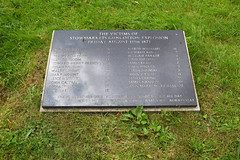| |
|
Stowmarket
Old Cemetery opened in 1855, after an Act of
Parliament put an end to burials in urban
churchyards. It is a small cemetery, set out on
the road towards Bury. The two chapels, one
Anglican and the other non-conformist, are almost
entirely identical. They are in a typical red
brick and dressed stone Early English style, and
the architect was E G Pennington. Pevsner thought
it worth noting that they are not symmetrically
placed, which is certainly unusual. In many
cemeteries later in the century the paired
chapels would share a porte-cochère as
at Ely, and even in the 1850s it was usual to
place them in a juxtaposition to each other, as
at Ipswich. Here, however, the two chapels are
simply not talking to each other. Although they
are set either side of the main path through the
cemetery, one is down by the road to Bury and the
other is set back among the trees further up. I
assume that the one closer to the main road,
being more prominently placed, was the Anglican
chapel. On Friday, 11th August 1871, a
massive explosion tore through a guncotton
factory in the centre of Stowmarket. Twenty-eight
people were killed, and twenty-three of them were
buried in a mass grave in the cemetery.
| The cemetery soon proved too
small for the town, which expanded
rapidly in the second half of the
century, and it closed for burials in
1901 to be replaced by a much larger new
cemetery across the road. After many
years of abandonment, the Old Cemetery
was taken over by Stowmarket Town Council
in 2007 and is maintained as a wildlife
area. The two surviving cemetery chapels
are no longer in use. In
2013, a memorial to the twenty-eight
victims of the 1871 explosion was
unveiled in the Old Cemetery. Curiously,
it only bears the names of the
twenty-three people who were buried in
the mass grave in the cemetery, and not
the names of the five buried elsewhere.
|
|
 |
|
|
|

